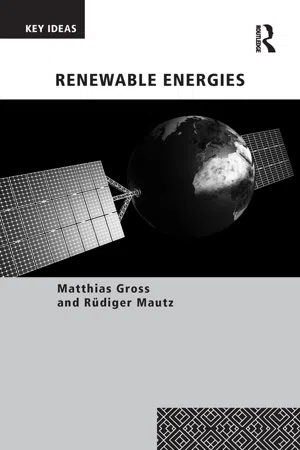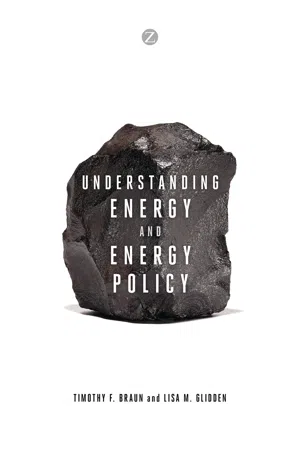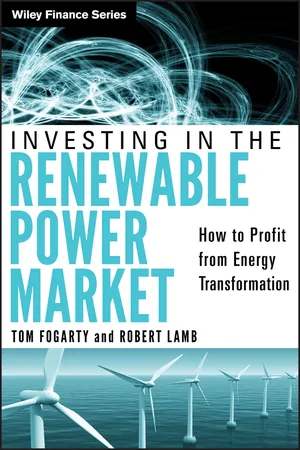Geothermal Power
Geothermal power is a renewable energy source that harnesses heat from the Earth's core to generate electricity. This is typically done by tapping into natural reservoirs of hot water and steam beneath the Earth's surface. Geothermal power plants produce minimal greenhouse gas emissions and provide a reliable source of energy, making them an important component of sustainable energy production.
6 Key excerpts on "Geothermal Power"
- eBook - ePub
- Matthias Gross, Rüdiger Mautz(Authors)
- 2014(Publication Date)
- Routledge(Publisher)
...These potential uses range from novel ways of heating homes to providing a significant share of the energy mix, especially if heat is tapped from several kilometers below the Earth’s surface. Given that many of the recently launched Geothermal Power plants and associated drilling technologies exhibit many scientific unknowns, questions relating to the unintended side effects of the method (including earthquakes) are of crucial importance. Since this type of energy can be harnessed at both an industrial and a household scale, important new interdisciplinary questions arise regarding the design of the technology and how it relates to existing sociotechnical systems. These questions also highlight the respective political valence of local energy production as opposed to large-scale, corporate production. Furthermore, the extrusion of lava from volcanoes reminds us in rather dramatic fashion that an enormous amount of heat exists in the Earth’s interior. This heat generates pressures that, in some cases, are manifested only a few kilometers below the Earth’s surface. It is these pressures that contain huge amounts of energy. However, there is also a constant flow of heat that, in theory, can be tapped from literally any part of the Earth’s surface. Geothermal fluids are essentially rainwater that has gradually seeped into the ground and is then heated by hot rock. Only a fraction of these heated fluids ever returns to the Earth’s surface (in the form of geysers or hot springs); most of it stays deep below ground. What geoengineers are now seeking to do effectively is to extract these fluids with appropriate drilling technology in order to use it for heating or for the production of electricity. As a source of energy, heat from the Earth appears to have great potential to satisfy the growing energy needs of modern societies. In general, geothermal heat (from the Greek: geo = earth, and therme = heat) is energy derived from the natural heat below the Earth’s crust...
- eBook - ePub
- Paul Breeze(Author)
- 2014(Publication Date)
- Newnes(Publisher)
...Chapter 12 Geothermal Power Abstract Geothermal energy is the heat energy contained within Earth’s body. This heat sometimes creates underground reservoirs of hot water. Drilling into these will release high-pressure steam and water that can be used in a steam turbine to produce electric power. Such reservoirs are normally found along tectonic plate boundaries. Elsewhere there are regions of hot rock close to Earth’s surface that can be exploited by drilling and then pumping high-pressure water into the rock where is heated and then extracted. The temperature of water in geothermal reservoirs is relatively low and the efficiency of energy extraction is low too. Energy extraction is usually by steam turbine. This can be driven directly if the reservoir provides steam, but if the energy source is hot water then a flash steam plant is normally used. For very low-temperature reservoirs a binary cycle turbine system is preferred. Keywords geothermal reservoir hot rock magma direct steam geothermal plant flash steam plant binary plant Geothermal energy is the heat contained within Earth’s body. The origins of this heat are found in the processes that led to the formation of Earth from the consolidation of stellar gas and dust some 4 billion years ago into a high-temperature ball of matter. Over time the outer regions of that ball cooled but the core remains at a very high temperature. Radioactive decay within Earth’s body continually generates additional heat that augments that already present. The distance from Earth’s surface to its core is 6500 km. At the core the temperature may be close to 6000 °C, creating a temperature gradient between the center and the much cooler outer regions. As a consequence, heat flows continuously toward the surface. Most of this heat reaches the surface at a low temperature and cannot be exploited, but in some places a geothermal anomaly creates a region of high temperature close to the surface...
- eBook - ePub
- Timothy Braun, Lisa Glidden(Authors)
- 2014(Publication Date)
- Zed Books(Publisher)
...7 | GEOTHERMAL ENERGY Geothermal refers to extracting heat from the Earth. The earliest examples of geothermal energy were various types of in-ground houses that helped keep their residents warm in the winter. The ground holds heat and stays much warmer than the air in winter. In a few areas hot water from the ground has also historically been used to heat homes, in what is called ‘passive’ geothermal. We begin this chapter with a discussion of passive geothermal. We then move to the more active uses of geothermal such as electricity production. There are three case studies included in this chapter – Iceland, Turkey, and Australia. Iceland is rich in high-temperature resources, and is the top country in terms of the percentage of electricity consumption met by geothermal. Turkey is rich in low-temperature resources, primarily used for district heating. Australia is rich in unconventional geothermal resources. About twelve gigawatts (GW) of geothermal electricity production was installed worldwide as of 2012. This is about 0.2 percent of global electricity production, but is a significant proportion of total electricity production for some countries, such as Iceland (30 percent), the Philippines (27 percent), and El Salvador (25 percent). The USA has the most installed geothermal generating capacity at about 3,100 MW, but this is a very minor proportion, 0.3 percent of total US generating capacity. Passive geothermal heating with hot groundwater can make a substantial impact on a country’s total energy usage, as evidenced by Iceland, which heats most buildings and provides indoor hot water with geothermal hot water. Combined with geothermal electricity production, this means that Iceland gets a large share, 60 percent in 2011, of its total energy requirements from geothermal sources, which is the highest in the world (Orkustofnun 2012)...
- eBook - ePub
Geothermal Power Generation
Developments and Innovation
- Ron DiPippo, Ron DiPippo(Authors)
- 2016(Publication Date)
- Woodhead Publishing(Publisher)
...1 Introduction to Geothermal Power generation L.Y. Bronicki Ormat Technologies Inc., Reno, Nevada, United States Abstract Geothermal energy is the only alternative energy source which can supply base-load or dispatchable power, independent of climate and weather. Although not evenly distributed geographically, geothermal energy potential is substantial in many countries. Today, more than 10 GW of Geothermal Power plants are in operation around the world. Unlike fossil fuel power plants, in Geothermal Power generation most of the capital costs are incurred up front in the development of the resource. The risks and challenges are all related to exploration, drilling, and managing the resource. Geothermal fluids come in a wide range of temperatures and consist of steam, brine of different chemical properties, as well as noncondensable gases. Power conversion is the most predictable part of a geothermal project, as it consists of well-established engineering designs. Most plants use steam turbines, and about 20%, use the Organic Rankine Cycle. The economic exploitation of a geothermal fluid of given characteristics is achieved by choosing the power station configuration so as to maximize the exergy efficiency of the whole system (resource and plant) and not only the thermal efficiency of the plant. The promising engineered geothermal systems aim at exploiting hot rock sources that are not accessible via conventional geothermal technology. Commercialization of this technology could unlock many thousands of megawatts of power, 100 GW in the United States alone. Keywords Geothermal energy; Engineered geothermal systems; Reservoir engineering; Organic Rankine cycle (ORC); Renewability; Sustainability Geothermal energy is the only alternative energy source that can supply base-load or dispatchable power, independent of the climate...
- eBook - ePub
Investing in the Renewable Power Market
How to Profit from Energy Transformation
- Tom Fogarty, Robert Lamb(Authors)
- 2012(Publication Date)
- Wiley(Publisher)
...Spent fluids from geothermal electric plants can be used subsequently for direct-use applications called cascaded operations. Savings can be as much as 80 percent under the cost of fossil fuels. In addition, geothermal energy usually has few, if any, pollutants, emissions, or toxic residues. The primary uses of direct geothermal heat are in district and space heating. A survey of 10 western states identified more than 9,000 thermal wells and springs, plus more than 900 low- to moderate-temperature geothermal resource areas and hundreds of direct-use areas. “Dry heat power is a specialized form of geothermal energy that escapes from hundreds of cracks in the Earth's surface. In order to fully exploit dry heat Geothermal Power, many very deep holes are drilled in the rock or the ground, and heat pumps are inserted down the holes to drive the heat up to the Earth's surface, where it is captured to be used directly in new commercial operations or municipal heating or cooling operations. In addition to the United States, Germany is substantially increasing government feed-in tariffs for geothermal energy development and distribution. Although geothermal energy is widely available globally, it does require the coexistence of very substantial amounts of heat, fluids, and permeability in reservoirs. If hydrothermal reservoirs do not exist, these can be engineered or man-made by exploiting hot rocks deep in the ground for commercial use. This alternative is widely known as a form of hot rock enhanced geothermal systems. There are normally five steps in the decision process for developing Enhanced Geothermal Systems and they include: 1. Find a site where hot rocks exist. 2. Create the reservoir. 3. Complete a well-field. 4. Operate the reservoir. 5. Operate the facility. Hot rock enhanced geothermal reservoirs require drilling wells down into hot rocks and fracturing the rock sufficiently to enable water to flow between the wells...
- eBook - ePub
- Volker Quaschning(Author)
- 2016(Publication Date)
- Routledge(Publisher)
...8 Geothermal energy Geothermal resources During the icy winter it may be hard to imagine, but the earth is a hot planet. Ninety-nine percent of it is hotter than 1,000 °C. Radioactive decay processes within the planet lead to temperatures around 6,500°C, hotter than the sun’s surface. It is, however, not possible for mankind to use this heat from within the earth’s core. We are merely made aware of our planet’s inner structure when, say, a volcano erupts, thereby bringing parts of the core to the surface in an uncontrolled fashion. The earth itself has layers a bit like an onion (Figure 8.1). It consists of a core, a mantle, and a crust. The core has a diameter of around 6,900 kilometres. There is an outer fluid core and an inner core consisting of solid iron and nickel at pressures up to 4 Mbar. Boreholes allow us to reach parts of the earth’s crust, which is up to 35 km thick. Relative to a reference temperature of 15 °C, the earth has a total heat content of 1.26·10 31 J, 5.4·10 27 J of which is estimated to be in the crust. This amount is several times greater than mankind’s primary energy demand of around 4·10 20 J. The temperature differences between the earth’s core and its crust lead to a constant flow of heat of between 0.063 and 0.42 W/m². Such low levels of heat current are by and large not suited to technical exploitation. Usually, deep boreholes are required for the exploitation of geothermal heat. The average geothermal depth gradient is 1°C/33 m. At a depth of 3,300 m, the temperature increases by 100 °C on average. However, the temperature does not increase at the same rate everywhere across the planet. There are especially great anomalies in areas where the continental plates meet (Figure 8.2). In areas with good geothermal resources, temperatures reach far above 100°C at a depth of only a few hundred metres. There are also great differences in Germany...





